英语语法基础(倒装与从句)
- 格式:pdf
- 大小:393.66 KB
- 文档页数:5
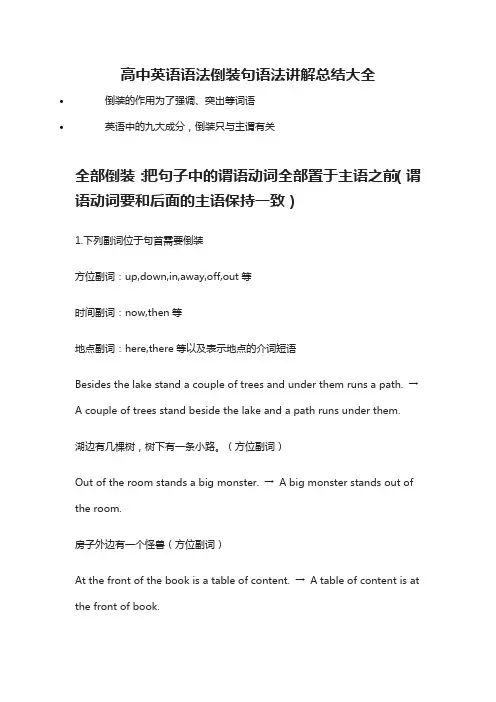
高中英语语法倒装句语法讲解总结大全•倒装的作用为了强调、突出等词语•英语中的九大成分,倒装只与主谓有关全部倒装:把句子中的谓语动词全部置于主语之前(谓语动词要和后面的主语保持一致)1.下列副词位于句首需要倒装方位副词:up,down,in,away,off,out等时间副词:now,then等地点副词:here,there等以及表示地点的介词短语Besides the lake stand a couple of trees and under them runs a path. →A couple of trees stand beside the lake and a path runs under them.湖边有几棵树,树下有一条小路。
(方位副词)Out of the room stands a big monster. →A big monster stands out of the room.房子外边有一个怪兽(方位副词)At the front of the book is a table of content. →A table of content is at the front of book.书的前部有目录(方位副词)Now speaks the headamaster. →The headmaster speaks now.现在说话的是班长(时间副词)Then came the chairman. →The chairman came then.然后主席来了(时间副词)Here comes the bus. →The bus comes here.公交车来了(地点副词)Sitting at the next table was a pretty girl waiting for someone.→a pretty girl waiting for someone was Sitting at the next table.隔壁桌坐着一个漂亮女人正在等着谁(地点介词短语)By the window sat a young man with a magazine in his hand. →A young man with a magazine in his hand sat by the window.窗户边坐着一个年轻人,手里拿着一本杂志(地点介词短语)Among these people was his friend Jim. →His friend jim was among these people.他的朋友吉姆就在这些人当中(地点介词短语)2. 表语位于句首,需要全部倒装(为了强调或者为了使句子平衡或者为了使上下文连接得更加紧密)Such are the facts. →the facts are such.事实就是这些Gone are the days when woman were looked down upon.→The days when woman were looked down upon are gone.女性被看不起的时代已经过去了3. 当主语是代词时,不能倒装Here it is(不倒装)——here is the book(倒装)Here you are(不倒装)——here are the students.(倒装)部分倒装:把句子中的部分动词置于主语之前(be 动词、情态动词、助动词),如果句中没有be动词、情态动词或者助动词,应当补充(do,does,did)置于主语之前。
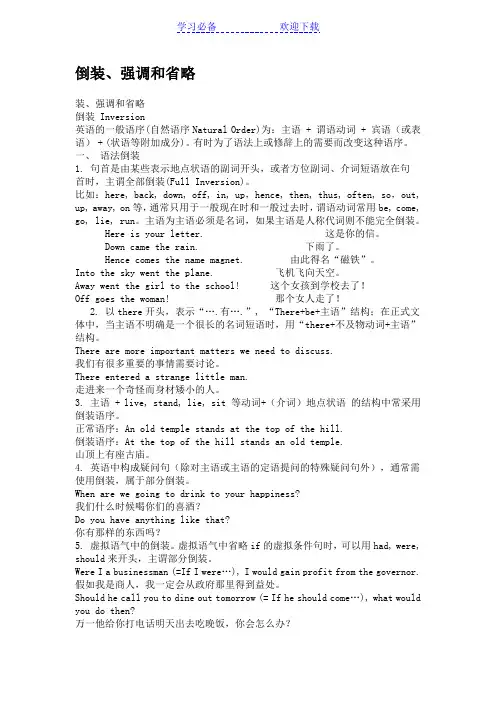
倒装、强调和省略装、强调和省略倒装 Inversion英语的一般语序(自然语序Natural Order)为:主语 + 谓语动词 + 宾语(或表语) + (状语等附加成分)。
有时为了语法上或修辞上的需要而改变这种语序。
一、语法倒装1. 句首是由某些表示地点状语的副词开头,或者方位副词、介词短语放在句首时,主谓全部倒装(Full Inversion)。
比如:here, back, down, off, in, up,hence, then, thus, often, so,out, up, away, on等,通常只用于一般现在时和一般过去时,谓语动词常用be, come, go, lie, run。
主语为主语必须是名词,如果主语是人称代词则不能完全倒装。
Here is your letter. 这是你的信。
Down came the rain. 下雨了。
Hence comes the name magnet. 由此得名“磁铁”。
Into the sky went the plane. 飞机飞向天空。
Away went the girl to the school! 这个女孩到学校去了!Off goes the woman! 那个女人走了!2. 以there开头,表示“….有….”, “There+be+主语”结构;在正式文体中,当主语不明确是一个很长的名词短语时,用“there+不及物动词+主语”结构。
There are more important matters we need to discuss.我们有很多重要的事情需要讨论。
There entered a strange little man.走进来一个奇怪而身材矮小的人。
3. 主语 + live, stand, lie, sit 等动词+(介词)地点状语的结构中常采用倒装语序。
正常语序:An old temple stands at the top of the hill.倒装语序:At the top of the hill stands an old temple.山顶上有座古庙。
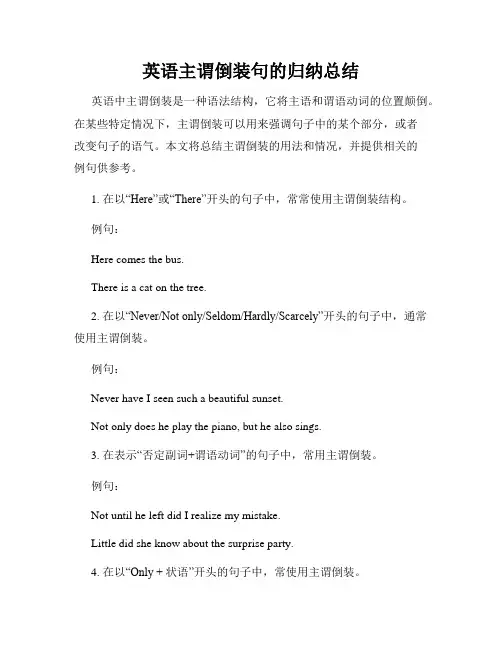
英语主谓倒装句的归纳总结英语中主谓倒装是一种语法结构,它将主语和谓语动词的位置颠倒。
在某些特定情况下,主谓倒装可以用来强调句子中的某个部分,或者改变句子的语气。
本文将总结主谓倒装的用法和情况,并提供相关的例句供参考。
1. 在以“Here”或“There”开头的句子中,常常使用主谓倒装结构。
例句:Here comes the bus.There is a cat on the tree.2. 在以“Never/Not only/Seldom/Hardly/Scarcely”开头的句子中,通常使用主谓倒装。
例句:Never have I seen such a beautiful sunset.Not only does he play the piano, but he also sings.3. 在表示“否定副词+谓语动词”的句子中,常用主谓倒装。
例句:Not until he left did I realize my mistake.Little did she know about the surprise party.4. 在以“Only + 状语”开头的句子中,常使用主谓倒装。
例句:Only by working hard can we achieve success.Only when the rain stops can we go outside.5. 在条件句中,如果以“Had/Should/Were/Could”开头,常常使用主谓倒装。
例句:Had he studied harder, he would have passed the exam.Should you have any questions, please let me know.6. 在省略了if的虚拟条件句中,常常使用主谓倒装。
例句:Were I you, I would quit that job immediately.Had we known about the party, we would have attended.7. 在以“Only if”引导的条件状语从句中,常常使用主谓倒装。
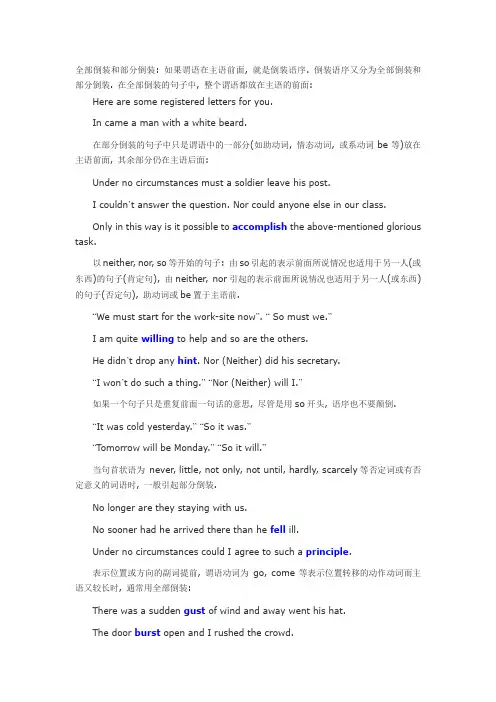
全部倒装和部分倒装: 如果谓语在主语前面, 就是倒装语序. 倒装语序又分为全部倒装和部分倒装. 在全部倒装的句子中, 整个谓语都放在主语的前面:Here are some registered letters for you.In came a man with a white beard.在部分倒装的句子中只是谓语中的一部分(如助动词, 情态动词, 或系动词be等)放在主语前面, 其余部分仍在主语后面:Under no circumstances must a soldier leave his post.I couldn’t answer the question. Nor could anyone else in our class.Only in this way is it possible to accomplish the above-mentioned glorious task.以neither, nor, so等开始的句子: 由so引起的表示前面所说情况也适用于另一人(或东西)的句子(肯定句), 由neither, nor引起的表示前面所说情况也适用于另一人(或东西)的句子(否定句), 助动词或be置于主语前.“We must start for the work-site now”. “ So must we.”I am quite willing to help and so are the others.He didn’t drop any hint. Nor (Neither) did his secretary.“I won’t do such a thing.”“Nor (Neither) will I.”如果一个句子只是重复前面一句话的意思, 尽管是用so开头, 语序也不要颠倒.“It was cold yesterday.”“So it was.”“Tomorrow will be Monday.”“So it will.”当句首状语为never, little, not only, not until, hardly, scarcely等否定词或有否定意义的词语时, 一般引起部分倒装.No longer are they staying with us.No sooner had he arrived there than he fell ill.Under no circumstances could I agree to such a principle.表示位置或方向的副词提前, 谓语动词为go, come等表示位置转移的动作动词而主语又较长时, 通常用全部倒装:There was a sudden gust of wind and away went his hat.The door burst open and I rushed the crowd.There comes the bus!Now comes your turn.1.如果主语是代词, 仍用正常语序:There comes your turn.有here引起, 谓语为be的句子, 也要倒装:Here is China’s largest tropical forest.Here are some picture-books.2.如果主语是代词, 仍用正常语序:Here we are. This is the new railway station.“Give me some paper.”“Here you are.”3.表语和系动词提前:介词短语: On the other side was northern Xinjiang.Near the southern end of the village was a large pear orchard.形容词: Very important in the farmer’s life is the radio weather report.Worst of all were the humiliations he suffered.副词: Below is a restaurant.Southwest of the reservoir were 2,000 acres of sandy wasteland.分词: Housed in the Cultural Palace are a library, an auditorium and recreation rooms.Hidden underground is a wealth of gold, silver, copper, lead and zink.Lying on the floor was a boy aged about 17.Standing beside the table was an interpreter.4 句首状语若由only + 副词, only + 介词词组, only + 状语从句构成, 引起局部倒装:Only yesterday did he find out that his watch was missing.Only through sheer luck did he manage to get some tickets.Only because there were some cancelled bookings did he get some tickets in the end.有not only开头的句子或分句, 往往引起局部倒装:Not only did he complain about the food, he also refused to pay for it.Not only did the garage overcharge me, but they hadn’t done a very good repair job either.1、词类冠词:关注冠词表示特指、泛指、类指的用法。

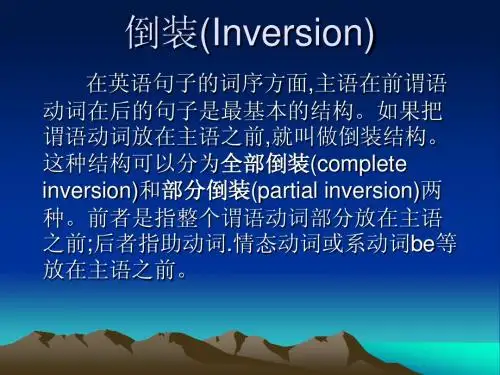

什么时候需要倒装,什么时候部分倒装。
英语中有许多否定词和否定词组,在句中用作状语、宾语或表语,当它们被置于句首时,常常引起倒装。
在这些倒装句中,如果谓语动词是动词的一般现在时或一般过去时形式,句子需要全部倒装,否则就只局部倒装。
其他倒装情况要看具体强调的是什么内容。
常见的放句首的否定词有:(句型: 否定词+ 助动词/be动词+ 主语)by no means 决不in no case 决不in no way 决不on no consideration 决不under no circumstances 决不in nocircumstances 决不barely 简直没有hardly 几乎不scarcely 几乎不little/few 几乎没有,一点也不never 从不no sooner ...than...一...就not 不,没有not a bit 一点也不not...until...直到...才nowhere 没有地方,无处rarely 很少seldom 很少only 只有not only...but also 不但...而且...例句:Barely does he have enough time to study.By no means is translation work easy.注意:1. 这些倒装的词,只有当Not only…but also连接两个分句时,才在第一个分句用倒装结构。
如果置于句首的Not only… but also仅连接两个并列词语,不可用倒装结构,例如, Not only you but also I am fond of music.Not only did she refuse the gift,she also severely criticized the sender.2. 对于not…until句型,当not until…位于句首时,其后的主句要用倒装语序。
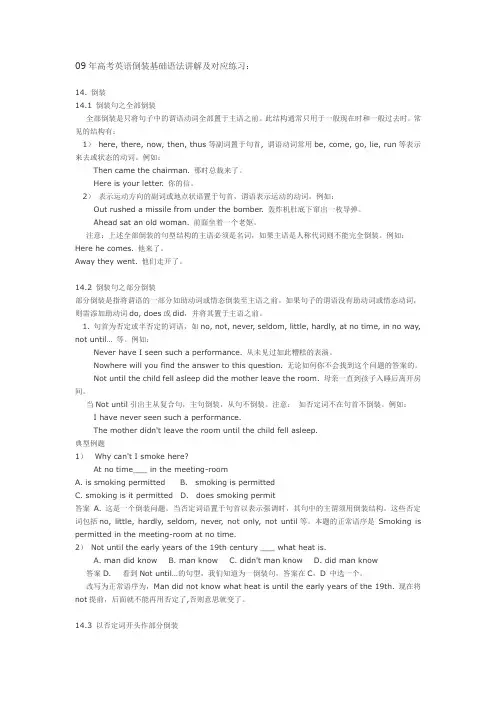
09年高考英语倒装基础语法讲解及对应练习:14. 倒装14.1 倒装句之全部倒装全部倒装是只将句子中的谓语动词全部置于主语之前。
此结构通常只用于一般现在时和一般过去时。
常见的结构有:1)here, there, now, then, thus等副词置于句首, 谓语动词常用be, come, go, lie, run等表示来去或状态的动词。
例如:Then came the chairman. 那时总裁来了。
Here is your letter. 你的信。
2)表示运动方向的副词或地点状语置于句首,谓语表示运动的动词。
例如:Out rushed a missile from under the bomber. 轰炸机肚底下窜出一枚导弹。
Ahead sat an old woman. 前面坐着一个老妪。
注意:上述全部倒装的句型结构的主语必须是名词,如果主语是人称代词则不能完全倒装。
例如:Here he comes. 他来了。
Away they went. 他们走开了。
14.2 倒装句之部分倒装部分倒装是指将谓语的一部分如助动词或情态倒装至主语之前。
如果句子的谓语没有助动词或情态动词,则需添加助动词do, does或did,并将其置于主语之前。
1. 句首为否定或半否定的词语,如no, not, never, seldom, little, hardly, at no time, in no way, not until… 等。
例如:Never have I seen such a performance. 从未见过如此糟糕的表演。
Nowhere will you find the answer to this question. 无论如何你不会找到这个问题的答案的。
Not until the child fell asleep did the mother leave the room. 母亲一直到孩子入睡后离开房间。

英语最基础的语法都有哪些英语最基础的语法都有哪些对于英语来说,除了我们经常背的单词以外,语法是英语的主要部分,也是极为重要的一部分,那么关于英语最基础的语法你们都知道哪些呢?【一】英语最基础的语法S=主语,V=谓语,P=表语,O=宾语,o=间接宾语,C=宾语补足语) 在此句式中,v是不及物动词,又叫自动词(vi.)。
例如:Everybody laughed.大家都笑了。
在此句式中,v是系动词(link v.),常见的系动词有:look, seem,appear, sound, feel, taste, smell, grow, get, fall ill/asleep, stand/sit still, become, turn等。
例如:The story sounds interesting.这个故事听起来有趣。
在此句式中,v是及物动词(vt.),因此有宾语。
例如:I love apples.我喜欢苹果。
【二】、英语最基础的从句1、感叹句(感叹句是表示说话是的惊讶、喜悦、赞赏、愤怒等情绪的句子.感叹句所修饰的部分除动词外必须提到前面,句中的剩余部分用正常语序,句末要用感叹号.)2、反意问句(反意问句附在称述句后面,多称述句所叙述的事情提出相反的疑问.该句型的结构特征为:1、先肯定则后否定 2、先否定则后肯定.)3、There be句型(句中表示某时、某处有某人或某物的时候,常用该句型,起基本结构为There be+主语+其他成分,there在这样的结构中是个引导词,没有实际含义.)4、主谓一致(主谓一致是指谓语动词在人称和数上必须和主语一致.)5、复合句(复合句是由一个主句与一个或一个以上的从句所构成的.在复合句中,主句是句子的主体,从句则用来充当主句中的某一个成分.)6、名词性从句(指主语从句、宾语从句、表语从句、同位语从句而言,该从句在句中起名词的作用7、定语从句(在复合句中修饰名词、代词、动名词、介词短语的句子叫定语从句.)8、状语从句(有:地点状语从句、时间状语从句、原因状语从句、目的状语从句、结果状语从句、条件状语从句、让步状语从句、比较状语从句、方式状语从句.)9、倒装(倒装是一种语法手段.用于强调某一句子成分或出与一定句子结构的需要.最基本的就是主谓倒装.倒装分为两种:一种是将主语谓语完全颠倒过来,叫完全倒装;另一种是只将助动词移到主语之前叫做部分倒装.)【三】、英语基础语法的种类第一,静词法。
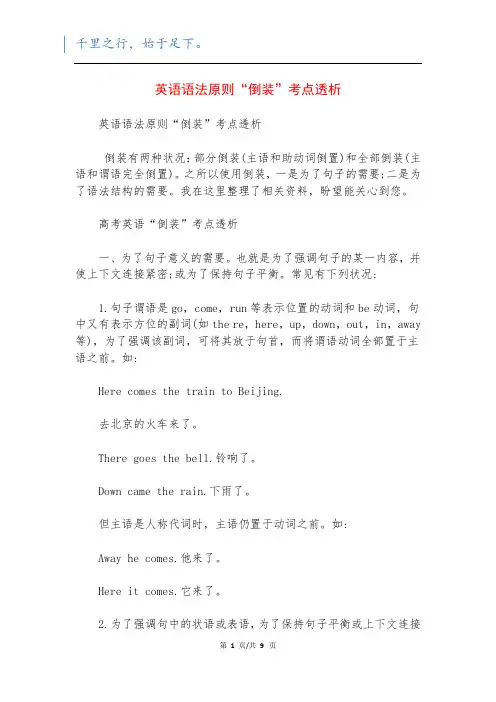
英语语法原则“倒装”考点透析英语语法原则“倒装”考点透析倒装有两种状况:部分倒装(主语和助动词倒置)和全部倒装(主语和谓语完全倒置)。
之所以使用倒装,一是为了句子的需要;二是为了语法结构的需要。
我在这里整理了相关资料,盼望能关心到您。
高考英语“倒装”考点透析一、为了句子意义的需要。
也就是为了强调句子的某一内容,并使上下文连接紧密;或为了保持句子平衡。
常见有下列状况:1.句子谓语是go,come,run等表示位置的动词和be动词,句中又有表示方位的副词(如the re,here,up,down,out,in,away 等),为了强调该副词,可将其放于句首,而将谓语动词全部置于主语之前。
如:Here comes the train to Beijing.去北京的火车来了。
There goes the bell.铃响了。
Down came the rain.下雨了。
但主语是人称代词时,主语仍置于动词之前。
如:Away he comes.他来了。
Here it comes.它来了。
2.为了强调句中的状语或表语,为了保持句子平衡或上下文连接紧密,可将状语或表语置于句首,句中主语和谓语完全倒装。
如:At the front of the hall sat the headmaster.校长坐在大厅的前部。
In this paragraph can be found an answer.在这段里能找到答案。
3.为了强调only及其所修饰的状语(通常是副词、介词短语或从句),则将它们移到句首,句中的主谓作部分倒装。
如:Only then did we realize that the man was blind.直到那时我们才发觉那个人是盲人。
Only when the war was over in 1918 was he able to get happily back to work.直到1918年战斗结束后,他才得以开心地重返工作岗位。
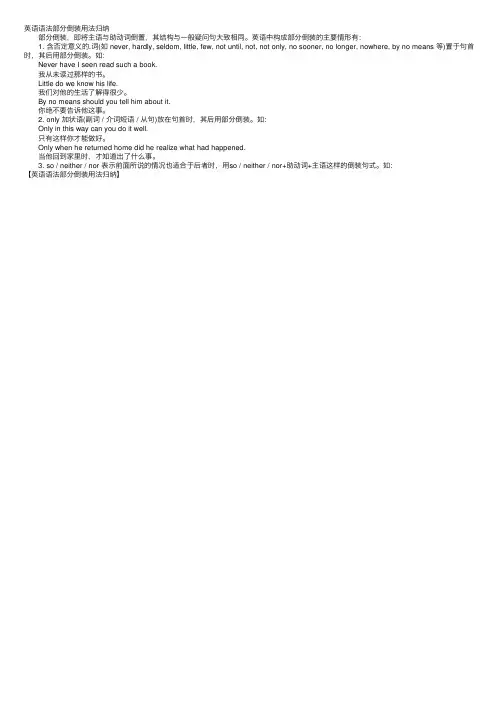
英语语法部分倒装⽤法归纳
部分倒装,即将主语与助动词倒置,其结构与⼀般疑问句⼤致相同。
英语中构成部分倒装的主要情形有:
1. 含否定意义的.词(如 never, hardly, seldom, little, few, not until, not, not only, no sooner, no longer, nowhere, by no means 等)置于句⾸时,其后⽤部分倒装。
如:
Never have I seen read such a book.
我从未读过那样的书。
Little do we know his life.
我们对他的⽣活了解得很少。
By no means should you tell him about it.
你绝不要告诉他这事。
2. only 加状语(副词 / 介词短语 / 从句)放在句⾸时,其后⽤部分倒装。
如:
Only in this way can you do it well.
只有这样你才能做好。
Only when he returned home did he realize what had happened.
当他回到家⾥时,才知道出了什么事。
3. so / neither / nor 表⽰前⾯所说的情况也适合于后者时,⽤so / neither / nor+助动词+主语这样的倒装句式。
如:
【英语语法部分倒装⽤法归纳】。
高中英语倒装句倒装句分为全部倒装和部分倒装1 全部倒装全部倒装是只将句子中的谓语动词全部置于主语之前。
此结构通常只用于一般现在时和一般过去时。
常见的结构有:1)here, there, now, then, thus等副词置于句首 , 谓语动词常用 be, come, go, lie, run等表示来去或状态的动词。
例如:Then came the chairman. 那时总裁来了。
Here is your letter. 你的信。
2). up,down,out,away, in , off, ahead 放于句首 Up jumped the cat and caught the mouse.Ahead sat an old woman.3)表示地点,时间,方向等的介词短语放在句首时例如:After the head walked a group of workers.4.“作表语的现在分词 /过去分词 /形容词 +系动词 +主语”形式的完全倒装Seated in the front were the guests.注意:上述全部倒装的句型结构的主语必须是名词,如果主语是人称代词则不能完全倒装。
例如:Here he comes. 他来了。
Away they went. 他们走开了。
2 部分倒装部分倒装是指将谓语的一部分如助动词或情态倒装至主语之前。
如果句子的谓语没有助动词或情态动词,则需添加助动词 do, does或 did,并将其置于主语之前。
1. 句首为否定或半否定的词语,如 no, not, never, seldom, little, hardly, rarely, scarely, in no way, under no circumstance, at no time决不 , not until 等⋯。
例如:Never have I seen such a performance从.未见过如此糟糕的表演。
高中英语知识点归纳倒装句的用法和情况高中英语知识点归纳:倒装句的用法和情况倒装句是英语语法中的一种特殊句型,与正常的语序(主语+谓语+宾语)相比,其主谓顺序颠倒,即谓语动词或助动词位于主语之前。
倒装句在不同的语境下有不同的用法和情况。
本文将归纳总结高中英语中常见的倒装句用法和情况,帮助同学们更好地理解和运用倒装句。
一、全部倒装句全部倒装句是指将整个谓语动词短语进行倒装。
以下几种情况常见于高中英语教材和考试中:1. 否定词位于句首在句首的否定词有:never, seldom, rarely, little, hardly, scarcely等。
句子中主语与谓语动词间需要加助动词do的倒装形式。
例句:Never have I seen such a beautiful sunset.Seldom does he come to visit his grandparents.2. 表示地点、方向或方式的状语位于句首当表示地点、方向或方式的状语置于句首时,主谓语序需要颠倒。
例句:Up the hill ran the children happily.In front of the mirror stood the beautiful girl.3. “Only+状语”位于句首当“only+状语”出现在句首时,需要对主谓语序进行倒装。
例句:Only by working hard can you achieve your goals.Only in this way can we solve the problem.二、部分倒装句部分倒装句是指将助动词或情态动词与主语之间的顺序颠倒。
以下是常见的部分倒装句情况:1. 条件状语从句中的倒装在以“should”开头的虚拟条件状语从句和“had”开头的虚拟条件状语从句中,助动词或情态动词应置于主语之前。
例句:Should it rain tomorrow, we will stay at home.Had I known the truth earlier, I would have made a different decision.2. so/such+形容词/副词+单数可数名词+that从句当so/such引导的句子中形容词/副词修饰名词或整个句子时,助动词或情态动词需要与主语倒装。
倒装句倒装的两种考法:1. 放在单项选择题中,考查考生的倒装语法知识是否熟练掌握;2. 放在完形填空和阅读理解中,设置理解障碍.倒装的两种形式:1. 完全倒装:将整个谓语动词提到主语前.2. 部分倒装:即半倒装,将谓语的一部分即助动词提到主语前.一、完全倒装1表方位的副词here, there 或out, in, up, down, away, off, over, back等标志词放在句首,句子用完全倒装.翻译句子1车来了. Here comes the bus.2铃响了. There goes the bell.3孩子们冲出来了. Out rushed the children.4那个男孩离开了. Away went the boy.疑难Here it is.In she came.Away he went.疑难剖析当主语是人称代词时,主谓语序不变.2地点状语放在句首且谓语动词为come, live, lie, go, sit, stand等时用完全倒装.完成例句5河的南面有一家小工厂.In south of the river lies a small factory. 6山谷里传来一声喊叫.From the valley came a cry.3 such, the following等放句首时,句子要完全倒装.翻译句子7Such are the facts. 情况就是如此.8生活就是这样. Such is life.9The following is the answer to the question. 这个问题的答案如下.4There lie / exist / stand / live +主语+…是there be 句型的变式翻译句子10山顶上有一幢高楼.There is a tall building on the top of the mountain.11山顶上耸立着一座古塔.There stands an ancient tower on the top of the mountain.5“表语+系动词+主语”的结构.例句观察Present at the party were Mr. Green and many other guests.出席晚会的有格林先生,还有一些别的宾客.Seated on the ground are a group of young men. 坐在地上的是一群年轻人.注意此时,主语较长,可还原为正常语序即:主+系动词+表语.二、部分倒装将情态动词、助动词、be提到主语前. 通常可以还原为正常的语序,并以此检验倒装句是否正确.1含有否定意义的副词或短语如:few, little, never, not, nowhere, rarely, seldom, at no time, by no means, in no case等放在句首时,需用部分倒装.翻译句子12Little does he know about the news. 他对这消息知之甚少.13By no means can he catch up in such a short time. 他根本不可能在这么短的时间里赶上来.疑难1He is active in personality, and he seldom stays indoors. 无助动词He is active in personality, and seldom does he stay indoors. 添加does疑难剖析1若原句中没有助动词,必须根据谓语动词的具体时态来确定相应的助动词do, does 或did.完成例句14—我有大量的工作要做.— I've got an enormous amount of work to do.—我也是.—So have I.15他,和他全家人一样,相信你是无辜的.He believed, as did all his family, that you were innocent. 16如果她不同意这个计划,Tom也不会同意.If she doesn‘t agree to the plan, neither will Tom.2so / as / neither / nor 为标志词放在句首时,句子用倒装.①表示前面所说的肯定情况,也适合于另一人或物时,句式如下:so / as + be 助动词或情态动词+主语.②表示前面所说的否定情况也适合于另一人或物时,句式如下:neither nor+ be 助动词或情态动词+主语.特别提醒①“so +主语+助动词或be动词”表示对上文肯定的内容加以肯定或赞同,意为“的确如此”;— It's raining hard. 天下着大雨.— So it is. 是的.②“主语+did +so”表示:“主语”这样做了. 例如:Tom asked me to go to play football with him and I did so. Tom要我去踢足球,我去了.3①“only +状语或状语从句”放在句首时,句子用部分倒装.②only之后跟的不是状语时不可倒装.完成例句17你只有用这种方法才能学好英语.Only in this way can you learn English well.18只有他有时间的话他才会来.Only if he has time will he come here. 19他被请了3次才来开会.Only after being asked three times did he come to the meeting.20Only that boy can work out the problem. 只有那个男孩才能解答出这个问题.21Only socialism can save China. 只有社会主义才能救中国.4在if引导的虚拟语气条件句中,从句谓语有助动词were, had, should 时,可将if 省略,而把 were, had, should 移到句首.翻译句子22如果我是你,我就不会那样做. Were I you, I wouldn't do that.特别提醒①若从句是否定句,则必须将 not放在主语后.② had必须是助动词.5在“so…that” 和“ such…that”结构中,将“so+adj. ”和“such+n. ”提到句首时,句子用部分倒装.完成例句23暴风雨如此厉害,整个屋顶都被吹掉了.So terrible was the storm that the whole roof was blown off. 24杰克是如此聪明的孩子,他能解答所有这些难题.Such a clever boy was Jack that he was able to work out allthese difficult problems.6often, always, once, many a time, now and then, every the other day, then等状语位于句首时,句子部分倒装.完成例句以前我经常提到他.Often did I speak of him.他常常帮助我做实验.Many a time has he helped me with my experiment.7在not…until…, no sooner…than…, scarcely/hardly…when,not only…but also…, neither…nor…,等否定词开头的句式中.完成例句约翰知道昨天才改变了主意Not until yesterday did John change his mind.她一坐下,电话就响了.Hardly had she sat down when the phone rang.他没去拜访她,他也不会这样做.Neither has he called on her,nor will he do so.她不但说的正确,而且说的流利.Not only did she speak correctly, but also she spoke fluently.8当as /though引导让步状语从句时,可出现“N/adj/adv/分词+as +S+V”或“V+as+S+助动词”的倒装形式.当表语是名词时,名词前不加任何冠词.完成例句尽管他们很勇敢,但这样的危险仍使他们感到畏惧.Brave as they were, the danger made them afraid.尽管他是孩子,但是他知道的很多.Child as he is, he knows a lot of things.虽然尝试了,但是她打不开门.Try as she might, she couldn’t get the door open.8当may 放句首,表达祝愿时,句子倒装.May you succeed.。
英语语法“倒装句”超级大汇总英语最基本的词序是主语在谓语动词的前面。
如果将句子的主语和谓语完全颠倒过来,这称之为完全倒装。
如果只将助动词或情态动词移至主语之前,谓语的其他部分仍保留在主语的后面,这称之为部分倒装。
下面是小简老师为同学们整理的倒装句的内容,一起来学习吧↓↓↓一.部分倒装1.否定副词位于句首时的倒装在正式文体中,never, seldom, rarely, little, hardly, scarcely, no sooner, no longer, nowhere 等含有否定意义副词若位于句首,则其后要用部分装:①I shall never forgive him. / Never shall I forgive him. 我永远不会宽恕他。
②He seldom goes out for dinner. / Seldom does he go out for dinner. 他很少出去吃饭。
③She hardly has time to listen to music. / Hardly does she have time to listen to music. 她几乎没时间听音乐。
④He little realizes how important this meeting is. / Little does he realize how important this meeting is. 他不甚明白这个会议的重要性。
⑤We had no sooner reached the airport than the plane took off. / No sooner had we reached the airport than the plane took off. 我们刚到机场,飞机就起飞了。
注意(1) 对于not…until句型,当not until…位于句首时,其后的主句要用倒装语序:He didn’t leave the room until the rain stopped. / Not until the rain stopped did he leave the room. 雨停了之后他才离开这房间。
英语语法:倒装句的用法总结英语最基本的词序是主语在谓语动词的前面。
如果将句子的主语和谓语完全颠倒过来,这称之为完全倒装。
如果只将助动词或情态动词移至主语之前,谓语的其他部分仍保留在主语的后面,这称之为部分倒装。
下面是为同学们整理的倒装句的内容,一起来学习吧↓↓↓一、部分倒装1、否定副词位于句首时的倒装在正式文体中,never,seldom,rarely,little,hardly,scarcely,no sooner,no longer,nowhere 等含有否定意义副词若位于句首,则其后要用部分装:①I shall never forgive him. / Never shall I forgive him. 我永远不会宽恕他。
②He seldom goes out for dinner. / Seldom does he go out for dinner. 他很少出去吃饭。
③She hardly has time to listen to music. / Hardly does she have time to listen to music. 她几乎没时间听音乐。
④He little realizes how important this meeting is. / Little does he realize how important this meeting is. 他不甚明白这个会议的重要性。
⑤We had no sooner reached the airport than the plane took off. / No sooner had we reached the airport than the plane took off. 我们刚到机场,飞机就起飞了。
注意:(1)对于not…until句型,当not until…位于句首时,其后的主句要用倒装语序:He didn’t leave the room until the rain stopped. / Not until the rain stopped did he leave the room. 雨停了之后他才离开这房间。
先讲倒装一.概念:英语句子通常有两种语序:一种主语在前,谓语在后,称为自然语序,另一种谓语在前,主语在后,称为倒装语序。
二.相关知识点按“主语+ 谓语”这种顺序排列的句子是陈述语序。
如果排列顺序变为“谓语(或谓语一部分)+主语”,就是倒装。
倒装句分为:完全倒装:整个谓语移至主语前面叫完全倒装。
部分倒装:只把助动词、系动词或情态动词放在主语之前叫部分倒装。
1. 当以there, here, out , in , up , down, away 等副词开头的句子,为了起到强调的作用,可构成倒装句,只把副词放在句首,主语和谓语位置调换,不加助动词。
Our teacher came in. ——>> In came our teacher.这种倒装要求:主语必须是名词。
主语是人称代词时,主语和谓语语序不变。
如 Here it is. A way he went.这类倒装句式一般只用一般现在时和一般过去时。
Here comes the bus.Out rushed the boys.2. how, then, just, often 表示时间的副词放在句首,可构成倒装句,只把副词放在句首,主语和谓语位置调换,不加助动词。
Then came 8 years of the Anti -Japanese W ar.3. 表地点状语的介词短语放在句首,要用倒装句式,以示强调。
这种倒装句也是主谓直接调换位置,不加助动词did, does,do.Under a big tree ___D_____, half asleep.A. did sat a fat manB. a fat man satC. did a fat man satD. sat a fat man4. there放在句首时,要用倒装句式。
在“there + be”结构中的谓语动词有时不用be , 而用表示类似“存在”观念的其他不及物动词。
如:live, stand, come, lie, flow, enter, rise 和appear等。
There came shouts for help from the river.There lies a large wheat field in front of the house.Many years ago there lived an old man in the wooden house. In front of the tower flews a stream.5. so + 动词+主语neither/ nor + 动词+主语表示两人的同样一个情况时,只能表示一件事,即上、下句所使用的动词、时态要一致。
否则要用so it is with…You can ride a bike. So can I .He has been to Beijing. So have I .The first one isn’t good, neither is the second.His uncle is a worker and has been working in the factory for more than ten years. So it is with his aunt.6. so+ 形容词/副词that 的结构状语从句可以用正常语序表示,也可以把so+形容词/副词放于句首构成倒装。
句型如下: so +形容词/副词+be/助动词/情态动词that +从句。
Light travels so fast that it is difficult for us to imagine its speed.= So fast does light travel that it is difficult for us to imagine its speed. So easy was the work that they finished it in a few days.7. done做形容词在句中做表语时,常把表语放在句首,要用倒装句式。
Gone forever are the days when the Chinese people had to use foreign oil.8. 否定副词not , never, seldom, nowhere, little , rarely 放于句首时要用倒装句式。
W e seldom get up at four in the morning. = Seldom do we get up at four in the morning.Not a single word from him could the enemy drag.Rarely have I heard of such a silly thing.9. hardly…when;scarcely…when…; no sooner…than…可以用正常语序 had hardly done when… did 或用倒装句式Hardly had + 主语+ done when… did 句式。
hardly所在的句子用过去完成时。
什么语从句在整个句子中就起什么语的作用,如主语从句就起主语的作用句子基本结构主+谓+宾+(宾补)简单理解主语后是动词的动词就是谓语,后面的对象就是宾语主+系+表am is are就是系动词,就是系语,is、am、are后面的就是表语(一般而言)look,seem, feel, sense, taste, smell, sound表感官时也起到系动词的作用,视为系动词,后接表语,多为形容词1.主语从句1)主语从句可直接位于主语的位置,如果从句较长,谓语又较短,可用it作形式主语,而将从句放在句末。
常见的句型有:*It is a fact\a pity\a question\good news that...*It seems\appears\happened\has turned out that...*It is clear\important\likely\possible that...*It is said\reported\estimated\has been proved that...It is said that comic books create a connection between people of the same generation.It seems that the performance is very useful.2)what引导的主语从句表示“...的东西时”,一般不用it作形式主语。
What we lack is experience.3)what, who, when, why, whether等词含有各自的疑问意义,但它们引导的主语从句,都用陈述语序。
How the plan is to be carried out should be discussed again.I did know why I felt like crying.2.宾语从句1)宾语从句可位于及物动词、介词和某些形容词后。
连词that常可省略。
介词后一般接疑问词引导的宾语从句。
in that(因为),except that(除了),but that(只是)已构成固定搭配,其他介词后一般不接that引导的宾语从句。
*I promised that I would change the situation.*All this is different from what American young people would say about friendship.*He is certain that watching so much television is not good for children.*This article is well-written except that it is a bit too long.2)宾语从句后如有宾补,要用形式宾语it来代替,而把宾语从句移至宾补之后。
He has made it clear that he would not change his mind. (clear就是宾补,对宾语起补充说明作用的就是宾补)注:3)在think, believe, suppose, expect等动词后的宾语从句中,如果谓语是否定的,一般将否定词移至主句谓语上,宾语从句则变成肯定形式。
He didn't think that the money was well spent.3.表语从句表语从句出现在结构为“主语+系动词+表语从句”的句子中。
表语从句除可用that, what, when, why, whether, how等引导外,还可由because, as if(though)等引导。
that常可省略。
如主句主语为reason,只能用that引导表语从句,不可用because.Perhaps the most important thing to remember is that there is no one common type of life in A merica.The reason why so many people died there is that there were not enough food supplies.It looks as if successful international cultural communication will make the world smaller.4.同位语从句同位语从句用于对前面出现的名词作进一步说明,一般用连词that引导,由于先行名词的意义不同,也可用whether, who, when, where, what, why, how等引导。
常见的先行名词有fact, idea, belief, news, hope, conclusion, evidence, suggestion, order, problem, report, decision. 有时由于谓语较短,将同位语从句位于谓语之后。
She finally made the decision that she would join the fashion show.I had no idea how many books I could borrow at a time.The news came that their team had won the championship.5.定语从句定语从句所修饰的先行词可以是名词或代词,也可以是一个句子。